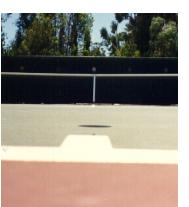|
STEPS
 Welcome to the free instructional area that will change your perception of tennis and of your tennis lesson. The help here applies equally to both you and any pro of any era, from Sampras, Agassi, Venus or Serena, to Laver, Emerson, Budge, even Bill Tilden. Welcome to the free instructional area that will change your perception of tennis and of your tennis lesson. The help here applies equally to both you and any pro of any era, from Sampras, Agassi, Venus or Serena, to Laver, Emerson, Budge, even Bill Tilden.
An underlying structure to tennis exists that predetermines how you move and how you structure the body into a strong foundation for contact, yet it's not addressed in any books. This information is not unique to our time, it is evident in every game of every era, and it can be seen on every tennis video even though the narrative instructs something else.
Step 1
The Geometric Reality of Tennis
The undeniable, unavoidable, ultimate truth to tennis that affects everything else. You want to move into the ball? Here's what that really means. Math is not required.
|
Step 2
How the Feet Work
Footwork has never been so convoluted as it is for tennis. You know, if the ball is close I go like this, if far I go like that; if short I go like so, if deep like... There should be a simple, elegant unity of movement. Understanding we are human, and the undeniable truth of Step 1, helps define footwork for tennis players.
|
Step 3
Your Body's Power Zone
Introducing the forward stance, the main theme from which all other stances derive and aspire to. If we had more than two legs and two arms we could perform simple tasks in a variety of ways, but we don't. Simple tasks such as lifting a box, or writing a check for earth humans adhere to one simple precept, and when applied to tennis the result is the forward stance.
|
Step 4
Your Body's Power
The Holy Grail. But the road map starts with Step 1, and goes through Step 2 and Step 3 first, or else the tennis meanies will get you and you're back to where you started from. Your power method is counterproductive and is the main reason for your inconsistency. There is a simpler way.
|
Step 5
Control Your Power
Don't rock the foundation at contact, you're not standing above your own fault line. Human balance as applied to tennis = strength and stability. Lots of pictures..
|
Step 6
Stroke Commonalities: Lots of
Useful Stuff
What is common to all strokes. Hitting through the middle of the ball, not what you think or have seen. The deepest tennis secret, 2 directions for 1 contact. The ultimate striking theory. Racket acceleration
|
Step 7
Stroke Commonalities 2: More
Useful Stuff
Vision: seeing the ball clearly means you'll hit on time. Ball placement: go with the stroke's strength. The contact zone: it doesn't lie between the hips and shoulders. Leverage concepts: all arms are built the same and are used similarly for best results.
|
Step 8
The Forehand Groundstroke:
In Two Parts
The arm flexes, the elbow moves forward, the hand pronates - just what the tennis establishment says shouldn't be done? You bet, and feel free to decide what makes more sense. An in-depth expose that separates the wheat from the chaff. You want a cannon on that side? Then please give this lengthiest Step the time it needs to deliver the instructions and it's yours..
|
Step 9
The Backhand Groundstroke:
In Two Parts
The backhand remains a mystery. The trouble is we don't see what's before our eyes. And it's right there. The solution is symmetry. Of feet, of body, of everything to make the backhand strong like the forehand. Say, "buh-bye, weakness."
|
Step 10
The Volley
Time to put a round peg in a round hole, not a square hole.
|
Step 11
Serve Return and Approach Shot
Returning serve better is not about the stroke, information you can find anywhere. It's all about the direction in which you move, it's about knowing how to move into the ball. And a little matador in you wouldn't hurt.
|
Step 12
The Serve .......in many parts
The forehand hit above your head. If it were all about a linear kinetic chain, then the bigger the better, but that's not reality. Something's missing. Not kinetic chain but Holistic.
|
On Rotation
This is a progression on body rotation compiled from previous Steps that helps clarify the revolutionary proposition that body rotation is counter productive to success for a tennis player.
|
Grand Unification Theory
The theory of everything, the Really Big Picture. Your relationship with the ball equals success. Here you'll find, literally, the blueprints that explain both the "why" of success and how to eliminate your weakness. Heady stuff here, but it's all about common sense.
|
Head-On
Do the pictures and words go together from these tennis instruction articles in magazines you read? Do the pictures reinforce how to play better? Obviously not. This is a rebuttal page: how dare he?
|
Modern Tennis?
Very old photos show topspin, open stances, wrap around follow throughs, and there was loading, exploding, and hitting when up off the ground. So are we modern?
|
White Papers
Individual white papers on some core issues and topics shedding a different light on either old or new topics in an effort to simplify the game.
|
Federer Vision Technique
How to look at the ball, how to watch the ball like Roger Federer. Watch the ball like Roger and enjoy better timing, better balance, better everything.
|
 |
 |
Home © Mark Papas
|
|
